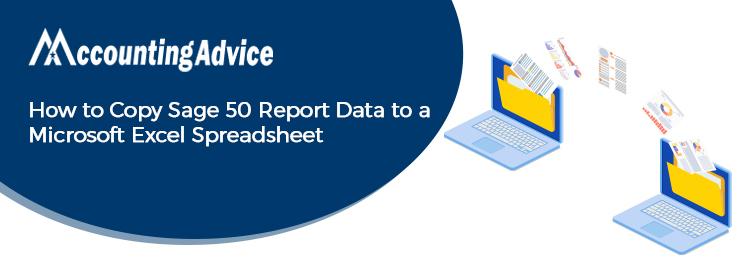How to Copy Sage 50 Report Data to a Microsoft Excel Spreadsheet

The Sage 50 Accounting software is widely appreciated all around the world for its comprehensive reporting tools and features. It generates a wide spectrum of reports to help you evaluate your business performance. These reports facilitate the comparison of your actual revenues and expenses of your company to the budgeted amounts. You can analyze these comprehensive reports to explore possible opportunities to increase revenue, reduce cost and expand the horizon of your business.
In this blog, we will discuss one important reporting feature embedded in Sage 50. We will look at how to copy Sage 50 Report Data to an MS Excel Spreadsheet. If you are yet to use this feature in Sage 50, we would recommend you to go through this blog. It will help you perform this task with ease and get the best out of the Sage 50 reports.
What Is the Procedure to Copy Sage 50 Report Data to an MS Excel Spreadsheet?
Here is a step-by-step procedure to copy Sage 50 Report Data to an MS Excel Spreadsheet-
Total Time: 35 minutes
Step 1- Perform any one of the following:
🔸 Go to the Select a Report or Form window
🔸 Choose the report/statement you want to copy from the list
🔸 From the top of the window, click on the Excel toolbar button.
🔸 Display on the screen, the report/statement that you want to copy
🔸 From the top of the window, click on the Excel toolbar button.
🔸 The Copy Report to Excel window will appear on your screen
Choose your preferred File option:
🔸 Create a new Microsoft Excel file or workbook
🔸 Add a new Excel worksheet to an existing workbook: you can choose this option to add to an existing file. Click on the Browse tab to select the desired Excel file.
Check /uncheck the Excel options as desired:
🔸 Use the freeze panes option: Check the box if you wish that the column titles in the Sage 50 report are treated by the Excel worksheet as ‘freeze panes’. if this is used, the elements within the panes remain visible, irrespective of whenever you scroll down or up in the worksheet
🔸 Enable Auto-filter (automatic column filtering): Check the box if you want to AutoFilter the data columns in the worksheet. You will locate AutoFilter arrows in columns that can be filtered so as to display a data range. To give you an example, if you enable the AutoFiltering feature for the Aged Receivables report, you will be able to filter by customer ID in the worksheet.
Choose your preferred Report header option
🔸 Send header to Page Setup: This option should be selected if you wish the Sage 50 report header information appears on the Header/Footer button of the Excel Page Setup window but, does not appear in the onscreen version of the Excel worksheet. On the Header/Footer section, you can make use of the Custom Header option to customize the header, before sending the worksheet to print. The header will be displayed on the printed version of the Excel worksheet. Also, all the column titles (column header information) will be exported to the worksheet.
🔸 Show header in the worksheet: This option should be selected if you wish the report header appears in the onscreen version of the worksheet and is not available for customizing in the Page Setup window. If you need, you can edit the header on the worksheet itself, before printing. Also, all the column titles (column header information) will be exported to the worksheet.
Choose the preferred Report layout option
This feature is available only in Sage 50 Premium Accounting and above
🔸 Sage 50 report layout: This option should be selected if you wish the data to appear in the worksheet with rows and columns formatted as in the original report.
🔸 Raw data layout: This option should be selected if you wish the data to appear in the worksheet with rows and columns unformatted, regardless of the original formatting.
Sage 50 report
🔸 Click OK when you finished making the selections.
🔸 Now, Sage 50 will start the Excel program. Copy the Sage report data into a blank worksheet. 🔸 Keep the worksheet name the same as that of the Sage 50 report.
In the discussion above, we have shown you how to copy Sage 50 Report Data to an MS Excel Spreadsheet. Hope this will be of great help to you. If you still have any more queries, you may reach out to some authorized Sage 50 experts 1800 964 3096
FAQs
Can I copy Sage 50 Report Data to an MS Excel Spreadsheet, in all versions of Excel?
For this feature of Sage 50 to work properly, you must have MS Excel 2003 or any newer version installed on your system. Copying of reports to Excel may work with versions before 2003 (for example, Excel 2002), but it will not be specifically supported by the Sage 50 software.
How to print a Sage 50 Report?
Please follow the procedure mentioned below-
🔸 Open Sage 50
🔸 Open your company.
🔸 Go to the Reports & Forms menu
🔸 Choose the Report area
🔸 The window named Select a Report or Form will appear on your screen
🔸 Select your report
🔸 Click on the Print button
🔸 Set any of the Filter options as per your requirement
🔸 Click OK to print
🔸 The Print dialogue box would appear on your screen
🔸 Click OK to start printing the report.
What are the reports I can run in Sage?
🔸 Here is a list of reports you can run in Sage-
🔸 Detailed reports
🔸 Essential reports.
🔸 Tax reports.
🔸 Online payment reports.
🔸 Data reports.
🔸 Products & services reports
🔸 Cash reports.
